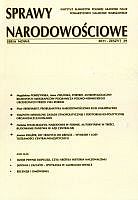Portret antropologiczny rdzennych mieszkańców pogranicza polsko-niemieckiego urodzonych p rzed 1945 rokiem
An Anthropological Portrayal of the Native Inhabitants of the Polish-German Borderland Born Before 1945
Author(s): Anna Zielińska, Magdalena PokrzyńskaSubject(s): Cultural Essay, Political Essay, Societal Essay
Published by: Instytut Slawistyki Polskiej Akademii Nauk
Keywords: native inhabitants; the Polish-German borderland; internal identity; external identity
Summary/Abstract: The article presents the results of field research carried out among the native inhabitants of the Lubusz Voivodship who were born in the former eastern territory of the then German state before 1945. Between 2009 and 2011, the authors conducted in-depth anthropological interviews with 28 informants in 17 localities in the Voivodship. These informants are the last remaining representatives of the former populace in this area, since the majority of the local inhabitants left Poland: some were evacuated or fled in the face of the advancing Red Army in 1945, some were victims of the so-called “wild” expulsions, as well as resettlements and a policy of bringing families together. One more factor was an economic emigration, which has continued up to the present day. Thus, those inhabitants who remained are the last witnesses to the history of life experiences which began here already in pre-World War II times. This makes them special and their status has a unique sense of rootedness in the region, unlike other inhabitants, who are newcomers here. The external identity of the interviewees, that is the identity given to them by others, is often different from their internal, subjective identity, which is felt and expressed in narratives. In the period following World War II the native populace was termed “autochtons.” The category of “autochton” was constructed from the outside, taking into consideration only elements of Polish culture, and completely ignored any ties with German culture. The presence of the “autochtons” officially served the purpose of legitimizing the so-called “recovered territories,” that is the territories incorporated into Poland in 1945. On the other hand, the autochtons were ascribed a German identity by new settlers who arrived in the Lubusz land from different regions of Poland, and who labeled the locals “Germans,” “Nazis,” “Germany.” The internal identity of the interviewees is characterized by Polish-German cultural biwalence, which shows most of all in their active bilingualism and often in denominational conversions or bivalent (catholic-evangelical) faith as well as a lack of a univocal acceptance of just one national option
Journal: Sprawy Narodowościowe
- Issue Year: 2011
- Issue No: 39
- Page Range: 7-25
- Page Count: 19
- Language: Polish

